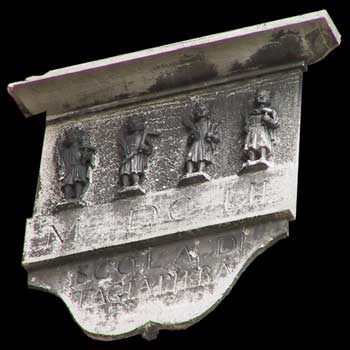
Quella dei Tajapiera fu tra le piú antiche Scuole d'Arte veneziane. La Mariegola (Regola Madre), cioé l'atto costitutivo, risale al 1307. La Scuola, riunitasi sotto la protezione dei Quattro Santi Coronati, fu ospitata inizialmente presso l'Ospedale di San Giovanni Evangelista dove, in una stanza a piano terreno messa a disposizione dal Priore, avvenivano le adunanze del Capitolo, cioé del Consiglio dell'Associazione, presiedute dal Gastaldo. Come le altre Scuole Minori, anche quella dei Tajapiera aveva compiti di mutua assistenza e di controllo sulla qualità del lavoro. L'Arte si divideva in quattro gradi: garzoni, lavoranti, maestri, padroni di officina; questi ultimi erano detti anche paroni de corte, perché le pietre e i lavori più grossi si facevano nei cortili, all'aria aperta. Nel 1515 la Confraternita si trasferí presso la Chiesa di Sant'Apollinare (Sant'Aponal) dove, grazie all'interessamento di Pietro Lombardo, acquistó un fondo dalla parte del campanile per costruirvi la propria sede: tale costruzione, in calle del Campanile, presenta ancor oggi nella parte alta della facciata un bassorilievo con i Quattro Santi Coronati e la scritta: "MDCLII SCOLA DI TAGIAPIERA". Di notte per Sant'Aponal si passava solo se si era "tagiapiera" o scultori e c'era un servizio di ronda per la sorveglianza. Soltanto nel 1724, o nel 1727 secondo il Sagredo, gli scultori si divisero dagli scalpellini. La sede della Scuola a Sant'Aponal era abbellita da vari dipinti, alcuni dei quali ora conservati presso le Gallerie dell'Accademia: la tavola di Vincenzo Catena con i Santi Coronati, che si trovava sull'altare, e il polittico di Sant'Ambrogio, di Bartolomeo Vivarini. Silvia Gramigna |
The School of Stonecutters in Venice MDLII ![]()

The Stonecutter Craft was between the most ancient Venetian Art Schools. The Mariegola (Mother Rule), which is the Constitution Board, is from the year 1307. The Craft, under the protection of the Four Crowned Saints, was in the beginning guested at the hospital of St. John the Evangelist where, in a ground floor room, the Chapter was holding its meeting under the presidence of a "Gastaldo". As well as other Minor Crafts, also the one of the Stone Cutters had dues of mutual assistence and of control on the quality of the works.
The Craft was composed in four degrees: apprentice, labourer, master, workshop owner; These last were also told "yard owners", as the stones and the most relevant works were managed in yards, in open sky. In 1515 the Brotherhood moved in the Church of St. Apollinare where, thanks to Pietro Lombardo, it could aquire a field near the Bell Tower to build up its seat. This building, still existing in calle del Campanile, shows near the top of the facade a bas-relief with the Four Crowned Saints and the inscription: "MDCLII SCOLA DI TAGIAPIERA". In the night time only people belonging to the Stone Cutters or Sculptors Craft were allowed to transit in The area of the School, and there was a surveillance service running. Only in 1724 (1727 according to Sagredo's chronicles), the Sculptors separated by the Stone Cutters. The seat of the Craft in St. Aponal was adorn of many painting, some of them are now preserved by the Accademia Galleries: the table by Vincenzo Catena showing the Four Crowned Saints, which was on the altar, and the polyptych of St. Ambrogio, by Bartolomeo Vivarini. Silvia Gramigna |